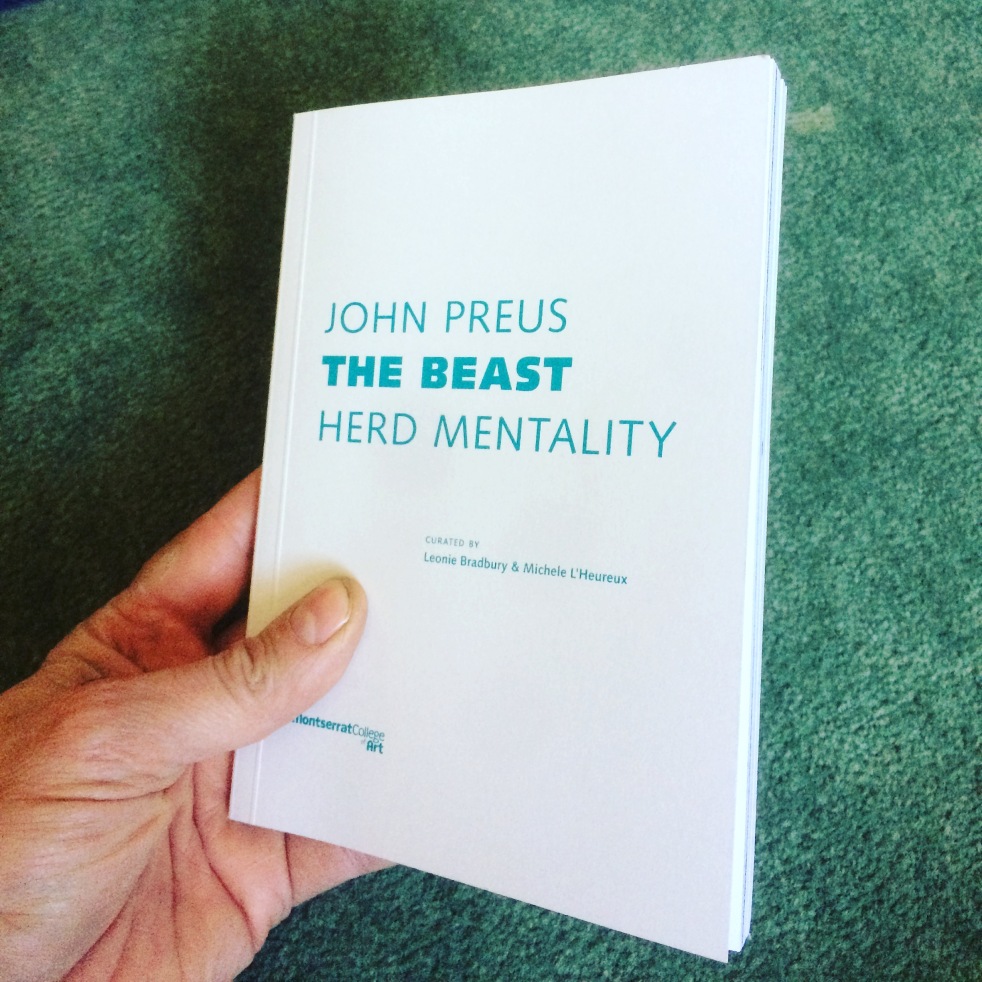
for more information about the Montserrat Beast:
Notes Toward an Iconology of the Faithless. March 4, 2018.
Identity is cobbled together on the fly. We find ourselves incomplete, unfinished, and wanting, governed by habits, desires, and longings, the origins of which remain largely opaque to us. The longing to belong, to fit in and be part of the herd strains against the impulse toward individuation. What does it mean to love your neighbor? It is the fundamental political problem. If there is no external arbiter of social tensions who can suspend the immediate need for action and resolution, the tensions can only play themselves out politically. If we can’t productively disagree, if we can’t entertain paradox, if we can’t maintain contradictory views simultaneously, the only recourse is violence. Perhaps the governing question posed by The Beast is, without a god to thank for good fortune and a devil to blame for our suffering, is civil society possible? I am not, of course, the first to ask this question. Nietszche warned of the rivers of blood that would result from the death of god.

Without an ethics of suspension that enables the possibility of sustained and non-violent disagreement, we are doomed to perpetual violence. The nuance of theology allows for at least an aspirational form of accommodation for those we don’t like or with whom we disagree. Political pragmatism necessarily drifts into authoritarian dogma precisely because it lacks this theology. I can’t see how you get from an is to an ought without it.


Art is dialectical, holding in opposition phenomena that do not readily adapt themselves to each other. Art is synthetic, stitching together a patchwork of conflicting impulses.The Beast is a temporary chapel for paradox, manifesting a theology of suspension. It is at once a sculpture–a thing to be observed and contemplated from a relatively safe distance, and an architectural intervention which houses the contemplation of its being. At the same time, it is a representational image of a totemic figure, trapped in the act of disrupting an event, thereby becoming the event itself. It is an action painting. Philosopher Simon Critchley offers this:
Another definition of art is that art is useless. You’re kind of performing the uselessness of these objects and then giving them another twist…So in a sense what you’re doing in here, brilliantly, is… the creation of… a space, a topos, which has a kind of openness to it, which points to a space which doesn’t yet exist and which has this unfinished capacity, which I would see in sort of moral or ethical terms. There’s an extraordinary technical precision that’s gone into the construction of this space…that’s both utopian and topian…but if utopianism is just abstract, it’s pointless.

In addition to being a space, The Beast is also an image that consumes us while we are simultaneously digesting it. In a public conversation with scholar and writer WJT Mitchell, I asked him, “What do you think? Is it alive or dead?” to which he responded, “I think it’s asleep, and dreaming of us.” He went on to say,
It’s a kind of wonderful sendup of the idea of the totem animal, but in this case, signifying the relation of art and public life,. the notion of a public sphere in our time, a place where people can gather who don’t know each other, but can gather for open discussion; Hannah Arrendt talks about this as “the space of appearance.” (It’s) very fragile and ephemeral. People get together, they can disagree, they can share opinions…
The Beast is a figurative parable that points to the possibility of freedom or awakening. Like Jonah, we are swallowed by the whale, but we enter and exit according to our own agency. The Beast is a boat trapped in the body of a sculpture, figuratively implying both destruction and liberation There is a dimension of culpability by which we are both the creature’s captors and its potential liberators.
Critchley reminds us that the relation between art and politics is one of “mannered situationism.” In order to make concrete interventions in the real world, and for our two- and three-dimensional ideas to find expression in the political realm, artists are structurally resigned to metaphor, parable, allegory, symbolic speculation, and theatrical projections of political and social possibilities. And yet, in the erudite opinion of curator Susanne Ghez, The Beast is like a town square. She says,
It’s clear from the exuberance here and the conversations that are happening, the people who found their way here today, that it’s not just hope, it’s a realization of something that people want to see, that they hope to see, but that they can see here.
Even so, it is a temporary town square at best, and maybe that’s all we can ask for – a temporary stage upon which to perform reality. I’m not the first to say that it is the moments in which our own lives seem to rise to the level of theater that they take on an ennobling quality, as if we inhabit a character drawn up for us with a perfectly-fitting costume, that we step into with gratitude, and from within which our future lays itself out before us. But that is precisely the danger of a good idea: scaled to certain proportions it becomes murderous. The thin line between ideology and commitment, is a beast.